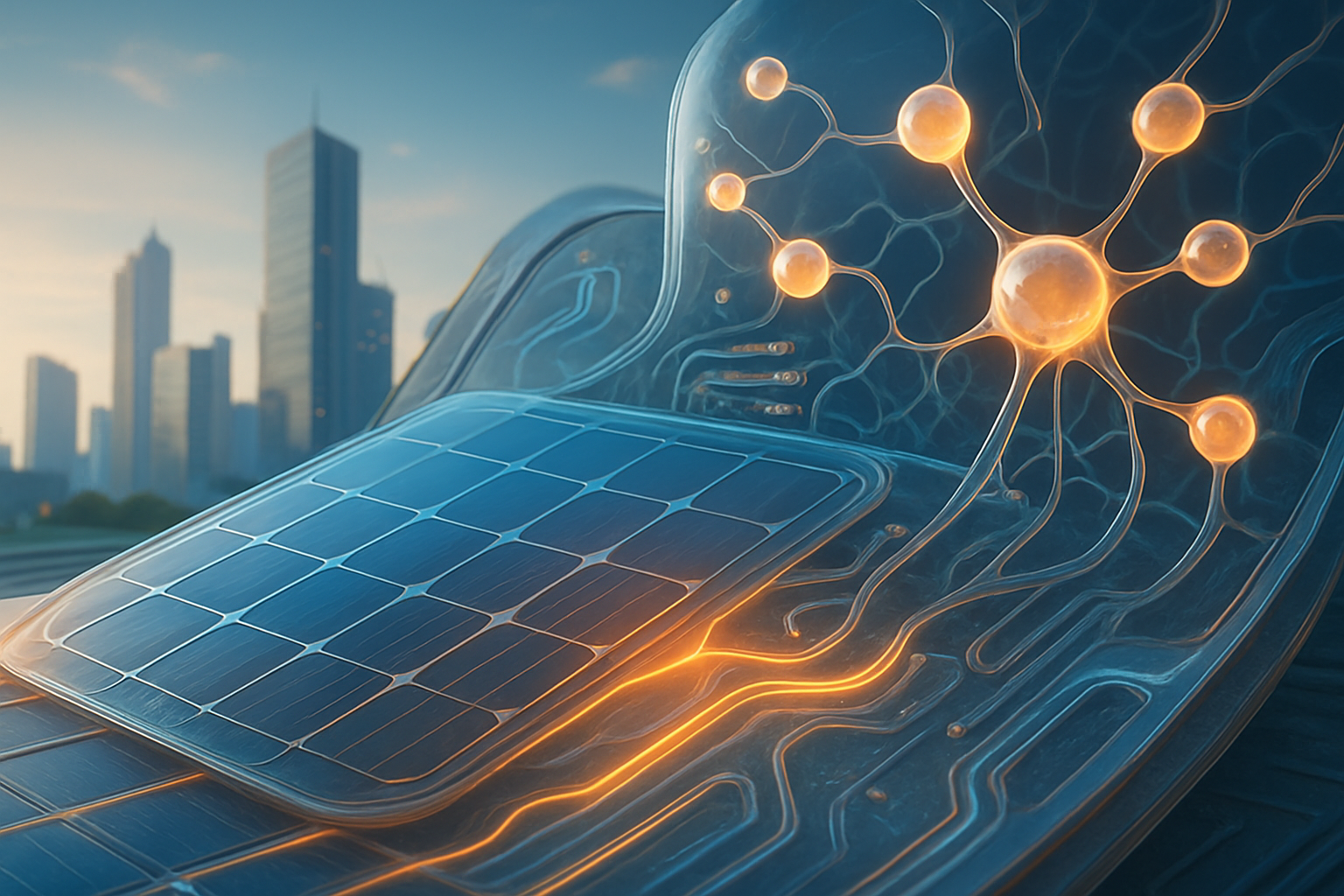Cambridge scientists have made a monumental breakthrough in solar energy, unveiling a novel organic semiconductor material named P3TTM that harnesses a previously unobserved quantum phenomenon. This discovery, reported in late 2024 and extensively covered in October 2025, promises to fundamentally revolutionize solar power by enabling the creation of single-material solar cells that are significantly more efficient, lighter, and cheaper than current technologies. Its immediate significance lies in simplifying solar cell design, drastically reducing manufacturing complexity and cost, and opening new avenues for flexible and integrated solar applications, potentially accelerating the global transition to sustainable energy.
Unlocking Mott-Hubbard Physics in Organic Semiconductors
The core of this groundbreaking advancement lies in the unique properties of P3TTM, a spin-radical organic semiconductor molecule developed through a collaborative effort between Professor Hugo Bronstein's chemistry team and Professor Sir Richard Friend's semiconductor physics group at the University of Cambridge. P3TTM is distinguished by having a single unpaired electron at its core, which imbues it with unusual electronic and magnetic characteristics. The "quantum secret" is the observation that when P3TTM molecules are closely packed, they exhibit Mott-Hubbard physics – a phenomenon previously believed to occur exclusively in complex inorganic materials.
This discovery challenges a century-old understanding of quantum mechanics in materials science. In P3TTM, the unpaired electrons align in an alternating "up, down, up, down" pattern. When light strikes these molecules, an electron can "hop" from its original position to an adjacent molecule, leaving behind a positive charge. This intrinsic charge separation mechanism within a homogeneous molecular lattice is what sets P3TTM apart. Unlike conventional organic solar cells, which require at least two different materials (an electron donor and an electron acceptor) to facilitate charge separation, P3TTM can generate charges by itself. This simplifies the device architecture dramatically and leads to what researchers describe as "close-to-unity charge collection efficiency," meaning almost every absorbed photon is converted into usable electricity.
Initial reactions from the AI research community and industry experts have been overwhelmingly positive. This discovery is not only seen as a significant advancement for solar energy but also as a "critical enabler for the next generation of AI." Experts anticipate that P3TTM technology could lead to significantly lower power consumption for AI accelerators and edge computing devices, signaling a potential "beyond silicon" era. This fundamental shift could contribute substantially to the "Green AI" movement, which aims to address the burgeoning energy consumption of AI systems.
Reshaping the Competitive Landscape for Tech Giants and Startups
The P3TTM breakthrough is poised to send ripples across multiple industries, creating both immense opportunities and significant competitive pressures. Companies specializing in organic electronics and material science are in a prime position to gain a first-mover advantage, potentially redefining their market standing through early investment or licensing of P3TTM-like technologies.
For traditional solar panel manufacturers like JinkoSolar and Vikram Solar, this technology offers a pathway to drastically reduce manufacturing complexity and costs, leading to lighter, simpler, and more cost-effective solar products. This could enable them to diversify their offerings and penetrate new markets with flexible and integrated solar solutions.
The impact extends powerfully into the AI hardware sector. Companies focused on neuromorphic computing, such such as Intel (NASDAQ: INTC) with its Loihi chip and IBM (NYSE: IBM) with TrueNorth, could integrate these novel organic materials to enhance their brain-inspired AI accelerators. Major tech giants like NVIDIA (NASDAQ: NVDA) (for GPUs), Google (NASDAQ: GOOGL) (for custom TPUs), Amazon (NASDAQ: AMZN), and Microsoft (NASDAQ: MSFT) (for cloud AI infrastructure) face a strategic imperative: aggressively invest in R&D for organic Mott-Hubbard materials or risk being outmaneuvered. The high energy consumption of large-scale AI is a growing environmental concern, and P3TTM offers a pathway to "green AI" hardware, providing a significant competitive advantage for companies committed to sustainability.
The lower capital requirements for manufacturing organic semiconductors could empower startups to innovate in AI hardware without the prohibitive costs associated with traditional silicon foundries, fostering a wave of new entrants, especially in flexible and edge AI devices. Furthermore, manufacturers of IoT, wearable electronics, and flexible displays stand to benefit immensely from the inherent flexibility, lightweight nature, and low-power characteristics of organic semiconductors, enabling new product categories like self-powered sensors and wearable AI assistants.
Broader Implications for Sustainable AI and Energy
The Cambridge quantum solar discovery of P3TTM represents a pivotal moment in material science and energy, fundamentally altering our understanding of charge generation in organic materials. This breakthrough fits perfectly into the broader AI landscape and trends, particularly the urgent drive towards sustainable and energy-efficient AI solutions. The immense energy footprint of modern AI necessitates radical innovations in renewable energy, and P3TTM offers a promising avenue to power these systems with unprecedented environmental efficiency.
Beyond direct energy generation, the ability to engineer complex quantum mechanical behaviors into organic materials suggests novel pathways for developing "next-generation energy-efficient AI computing" and AI hardware. This could lead to new types of computing components or energy harvesting systems directly embedded within AI infrastructure, significantly reducing the energy overhead associated with current AI systems.
The implications for energy and technology are transformative. P3TTM could fundamentally reshape the solar energy industry by enabling the production of lighter, simpler, more flexible, and potentially much cheaper solar panels. The understanding gained from P3TTM could also lead to breakthroughs in other fields, such as optoelectronics and self-charging electronics.
However, potential concerns remain. Scalability and commercialization present typical challenges for any nascent, groundbreaking technology. Moving from laboratory demonstration to widespread commercialization will require significant engineering efforts and investment. Long-term stability and durability, historically a challenge for organic solar cells, will need thorough evaluation. While P3TTM offers near-perfect charge collection efficiency, its journey from lab to widespread adoption will depend on addressing these practical hurdles. This discovery is comparable to historical energy milestones like the development of crystalline silicon solar cells, representing not just an incremental improvement but a foundational shift. In the AI realm, it aligns with breakthroughs like deep learning, by finding a new physical mechanism that could enable more powerful and sustainable AI systems.
The Road Ahead: Challenges and Predictions
The path from a groundbreaking laboratory discovery like P3TTM to widespread commercial adoption is often long and complex. In the near term, researchers will focus on further optimizing the P3TTM molecule for stability and performance under various environmental conditions. Efforts will also be directed towards scaling up the synthesis of P3TTM and developing cost-effective manufacturing processes for single-material solar cells. The "drop-in" nature, if it can be maintained, for integration into existing manufacturing lines could significantly accelerate adoption.
Long-term developments include exploring the full potential of Mott-Hubbard physics in other organic materials to discover even more efficient or specialized semiconductors. Experts predict that the ability to engineer quantum phenomena in organic materials will open doors to a new class of optoelectronic devices, including highly efficient light-emitting diodes and advanced sensors. The integration of P3TTM-enabled flexible solar cells into everyday objects, such as self-powered smart textiles, building facades, and portable electronics, is a highly anticipated application.
Challenges that need to be addressed include improving the long-term operational longevity and durability of organic semiconductors to match or exceed that of conventional silicon. Ensuring the environmental sustainability of P3TTM's production at scale, from raw material sourcing to end-of-life recycling, will also be crucial. Furthermore, the economic advantage of P3TTM over established solar technologies will need to be clearly demonstrated to drive market adoption.
Experts predict a future where quantum materials like P3TTM play a critical role in addressing global energy demands sustainably. The quantum ecosystem is expected to mature, with increased collaboration between material science and AI firms. Quantum-enhanced models could significantly improve the accuracy of energy market forecasting and the operation of renewable energy plants. The focus will not only be on efficiency but also on designing future solar panels to be easily recyclable and to have increased durability for longer useful lifetimes, minimizing environmental impact for decades to come.
A New Dawn for Solar and Sustainable AI
The discovery of the P3TTM organic semiconductor by Cambridge scientists marks a profound turning point in the quest for sustainable energy and efficient AI. By uncovering a "quantum secret" – the unexpected manifestation of Mott-Hubbard physics in an organic material – researchers have unlocked a pathway to solar cells that are not only dramatically simpler and cheaper to produce but also boast near-perfect charge collection efficiency. This represents a foundational shift, "writing a new chapter in the textbook" of solar energy.
The significance of this development extends far beyond just solar panels. It offers a tangible "beyond silicon" route for energy-efficient AI hardware, critically enabling the "Green AI" movement and potentially revolutionizing how AI systems are powered and deployed. The ability to integrate flexible, lightweight, and highly efficient solar cells into a myriad of devices could transform industries from consumer electronics to smart infrastructure.
As we move forward, the coming weeks and months will be critical for observing how this laboratory breakthrough transitions into scalable, commercially viable solutions. Watch for announcements regarding pilot projects, strategic partnerships between material science companies and solar manufacturers, and further research into the long-term stability and environmental impact of P3TTM. This quantum leap by Cambridge scientists signals a new dawn, promising a future where clean energy and powerful, sustainable AI are more intertwined than ever before.
This content is intended for informational purposes only and represents analysis of current AI developments.
TokenRing AI delivers enterprise-grade solutions for multi-agent AI workflow orchestration, AI-powered development tools, and seamless remote collaboration platforms.
For more information, visit https://www.tokenring.ai/


